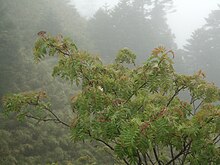维基百科:臺灣教育專案/臺大植物分類學 (106-2)/提報作業/Sorbus randaiensis
| 臺灣教育專案/臺大植物分類學 (106-2)/提報作業/Sorbus randaiensis | ||||||||||||||||||||
|---|---|---|---|---|---|---|---|---|---|---|---|---|---|---|---|---|---|---|---|---|
 | ||||||||||||||||||||
| 科學分類 | ||||||||||||||||||||
| ||||||||||||||||||||
| 二名法 | ||||||||||||||||||||
| Sorbus randaiensis (Hayata) Koidz., 1913 |
Sorbus randaiensis[2] is a deciduous tree of family Rosaceae. It's a endemic species in Taiwan and can be found in the mountain areas of middle Taiwan, with altitude 1,800m to 3,200m, mostly spotted in the forest of Xueshan, Hehuan Mountain, Template:Link-zh, and Nenggao Mountain. [3] It is a tree 3–8 m tall with white flowers and reddish fruit.[4]
Naming
[编辑]Koidz., The Journal of the College of Science, Imperial University of Tokyo, Japan 34(2): 52. 1913. (J. Coll. Sci. Univ. Tokyo)
It's species epithet randaiensis implies that the first type specimen is collected at Randaien Mountain, and to some degree connected to it's Chinese name Randaien. [5]
Description
[编辑]Deciduous trees with obvious lenticel on the branches.
Leaf
[编辑]Alternate, odd number pinnate leaves, with leaflets 15-21. Leaflets without petiole, shaped from long oval to lanceolate, 3-4 cm in length, 8-12 cm in width. The front end tapered, and the basal part skew, circled or obtuse. Margin jagged. Petiole with groove, and with short furs when young.
Flower
[编辑]Terminal corymbs inflorescence. Pedicels are short, about 3-4 mm in length. Petals 5, white. Hypanthium with long furs, triangle shaped. Stamens 15-20, Carpels 3-5, isolated. Styles 3-5, isolated or basal synthetic. Flower perigynous.
Fruit
[编辑]Schizocarp, berry-like, globular with diameter 7 mm. The front end has the remaining traces of stigma and calyx. Turn rubine at maturation. [6][7]
Phenology
[编辑]First leaf for the spring sprouts during April to May. Inflorescence is on about May to June. Around Srptember to October, their fruits ripen with rubine color. And in the October to November, their leaves turn yellow or red before falling down.[8][9]
Uses
[编辑]Medicine
[编辑]It's fruit, stem, and bark can be used as medicine. Although tasting bitter, it is a cure for chronic bronchitis and cough with phlegm, and is spleen-tonifying.
Ornamental
[编辑]It is eye-catching with their beautifully-shaped appearance from branching to flowers, especially the amazing change of leaves to red and rubine fruits in the October.
Food
[编辑]The fruits are with juicy texture and sweetness, tasting delicious. [10]
References
[编辑]- ^ McAllister, H.A. The genus Sorbus: Mountain Ash and other Rowans. Royal Botanic Gardens, Kew. 2005. ISBN 978-1842460887.
- ^ 昆明植物研究所. 台湾花楸. 《中国高等植物数据库全库》. 中国科学院微生物研究所. [2009-02-25]. (原始内容存档于2016-03-05).
- ^ 森態資料庫介紹 | 台灣山林悠遊網. recreation.forest.gov.tw. [2017-03-24].
- ^ Lu Lingdi and Stephen A. Spongberg. Sorbus randaiensis. Flora of China. Missouri Botanical Garden, St. Louis, MO & Harvard University Herbaria, Cambridge, MA. [1 July 2012].
- ^ 森態資料庫介紹 | 台灣山林悠遊網. recreation.forest.gov.tw. [2017-04-03].
- ^ 森態資料庫介紹 | 台灣山林悠遊網. recreation.forest.gov.tw. [2017-03-24].
- ^ 巒大花楸 Sorbus randaiensis - Plants of TAIWAN 台灣植物資訊整合查詢系統. tai2.ntu.edu.tw. [2017-03-24].
- ^ 森態資料庫介紹 | 台灣山林悠遊網. recreation.forest.gov.tw. [2017-03-24].
- ^ 雪霸國家公園. 巒大花楸. 雪霸國家公園. 2010-09-17 [2017-03-24].
- ^ 森態資料庫介紹 | 台灣山林悠遊網. recreation.forest.gov.tw. [2017-04-03].
- 峦大花楸 Sorbus randaiensis (Hayata) Koidz., 1913. 台湾物种名录. 台湾: 中央研究院生物多样性研究中心 (中文(台湾)).
